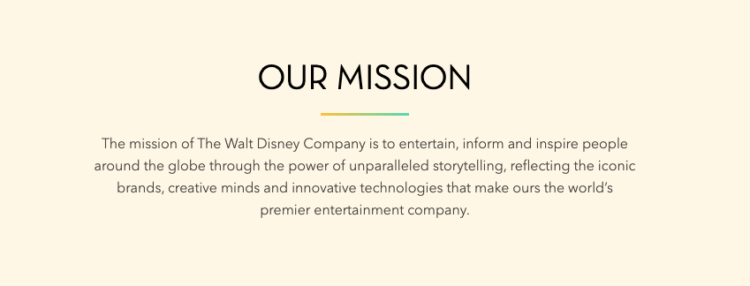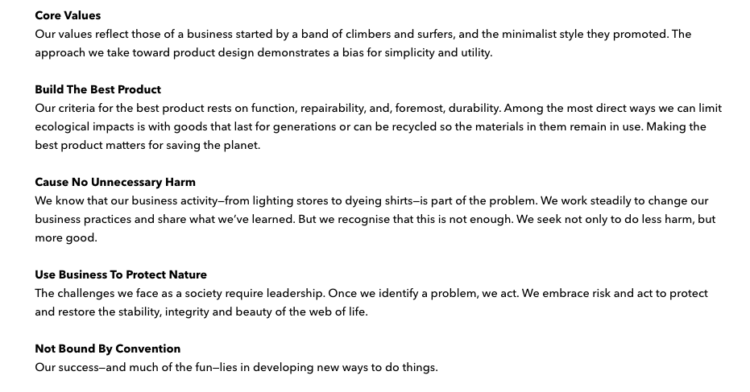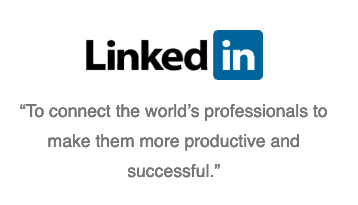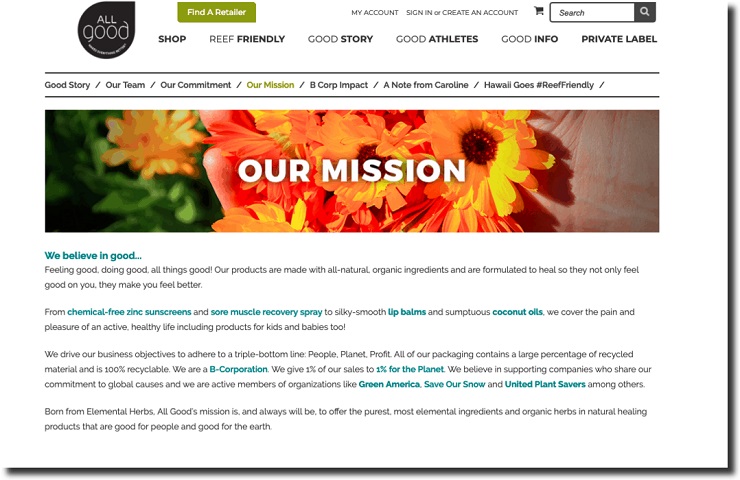What is your company’s reason for being?
Is it simply to get people to buy products, or for people to hire you? Or is there something else you long to accomplish, and your business is merely the path toward this accomplishment? Why do you want to accomplish this purpose with your company? What is it about the world you seek to change or improve?
You may have seen the word’s “mission statement” and “core values” floating around a lot. Without context, they may seem like fancy words big companies use to improve their marketing facade or ensure they don’t get sued.
However, a company’s core values, mission, and vision statements are not limited to big businesses.
They are essential for any business, regardless of where the business is in its growth period. They are the difference between your business flourishing or flopping.
Here at Business in a Box, we have our own core values, and mission statement that we use as our North Star:
- Our Core Values: Teamwork and Integrity, Determined to Deliver, Think Big, Learn, and Be Curious
- Our Mission is to build a household name entrepreneurial brand that impacts 10’s of millions of entrepreneurs every single week with our content and bring true entrepreneurial education to the masses to drive humanity forward.
Both our values and our mission have helped Business in a Box become the global success we are today. (You can read about them more on our About Page!) So, we have decided to give you all the information and guidance you could ever need to help you define who your business is, and who you want to be.
Why Your Business Needs Mission Statements And Values
When you start a business or when you are a business manager, you are doing far more than just creating a company. Sure, it’ll look and run like a company, but there’s a lot more going on than you may think.
Consider this: the most essential step in building a strong house is laying proper foundations. A house built on wonky foundations won’t last, and the more you build on top of those shoddy foundations the more likely a collapse will happen.
Building a company is no different.
The foundation on which you build your company needs to be solid. You need to have a strong base that will ensure your upwards growth over a long period of time. Your business needs to be structured, sustainable, and scalable.
The foundations of business building are your mission and vision statements, and your core values.
When you follow through on your business’s purpose by articulating your mission and acting on your company’s values, not only will you win more customers, but your customers will also be more likely to stick with you, through thick and thin.
Let’s delve into core values first, and then the mission and vision statement later on.
Core Values
Culture vs. Values
Some people get the two confused, so let’s examine the key differences between the two.
Culture is a flexible set of norms, an agreed-upon framework for how things are done. Culture applies to countries, families, companies, or any group, really.
Culture changes. The bigger the group, the longer it takes for these changes to occur, but it does change. As new people enter the mix, they bring with them their own interpretations and perspectives, and this influences how other members of the group think and feel.
Your core values, however, are fixed. Core values are the foundations of culture. They represent the fundamental beliefs around which culture develops. If you do a good enough job at determining and living your core values, your culture should always reflect this.
To show how core values are more permanent than culture, we’re going to look at a company that’s been around for a long time.
Walt Disney first started drawing cartoons and making movies because he wanted to entertain people. He wanted to make people laugh, smile, and enjoy themselves when they watched his movies.
Take a look at how they define themselves today:

Not really much different than how it started. But if we were to look at the culture of the Walt Disney Corporation now as compared to when it began, wow! Talk about change. A company that has been frequently accused of reinforcing racial and gender stereotypes now actively works to break down these barriers.
They’ve stayed this successful because they’ve never drifted from their core values, but also because their culture was able to adapt to changing circumstances and recognize when customers wanted the same thing in a different form. People still want to be entertained, but just not in the same way as they did in 1950.
As an entrepreneur, you need to figure out what it is that is unchanging about your company. Establishing this, in the beginning, will help you clarify what it is you need to be focusing on.
If anything takes you away from your business’s core values, you know it’s not worth your time.
How to Define Core Values
What’s Your Vision for the World?
What impact do you want to have on the world? Being able to effectively communicate your vision to members of your audience means you need to be completely sure what it is.
Start by asking yourself a few questions, such as:
- Who am I trying to help? How am I going to do it?
- How will people’s lives be different because of my company’s product or service?
- What needs to happen for my product or service to reach people?
If you can imagine a world that your startup is actively shaping, then you’re that much closer to making it a reality. After pinning down your vision, it will make it much easier for you to determine your core values.
For example, if you envision a world where it’s easier for people to freely express themselves, then freedom of expression will likely be one of your core values. Or if you see a world where people can safely store personal information on the web, then privacy and security will likely be a defining characteristics of your company.
Your vision for the world will help you be clearer about what you are trying to do, and this will put you in a better position for success.
What Problems Do You Solve?
A good business solves a problem. Usually, it’s a problem from your life that you share with others and to which no other solution exists. If this isn’t the case, then success will be much harder for you to achieve.
You’ll need to work to incorporate your purpose into your core values. But how exactly do you find this match between who you are and what your customers need?
There are a few ways to do this, but I personally like creating a “day-to-day customer map”.
This is an activity where you create a fictitious ideal customer and try to learn as much as possible about them and how they live. It’s important to be as specific as you can when creating this persona. Give them a name, and describe briefly who they are and what they do and don’t like.
Then, begin to map out their day, including even their smallest actions. What time do they get up? How do they get to work? When do they have lunch? What do they do after work?
Place these events as moments on a timeline, putting those that are positive or happy experiences near the top, and those that are negative or unhappy experiences at the bottom, making sure to come up with reasons why each experience is positive or negative.
As you work through this person’s life, you’ll begin to realize more about them. What do they value? How do they spend their time? What do they consider a waste of time?
You’ll quickly realize your company cannot possibly satisfy all of this person’s needs. And the solution you offer alone will not solve all of their problems. But your product or service will solve one, and that’s important.
By taking the time to learn your customers’ pain points, and by identifying where you fit into their quest to relieve this pain, you can position yourself as a company sensitive to the problems your target audience faces every day, helping to reinforce the connection between person and brand.
Gaining a detailed understanding of your customers, and how you solve their problems is essential for coming up with core values that will resonate and help you build a company that works for people.
One great example is Patagonia, the outdoor apparel company. Their mission statement reads:

If you go through Patagonia’s site, taking some time to see the work they do for the environment and other social causes, you’ll see how powerful these values have been in shaping this brand.
You’ll also want to tailor all your marketing, branding, and other communications to reflect these values. These traits are what make you special and different, so they need to shine through, one way or another, at every touchpoint.
Go through any policies you already have written and make sure they also reflect these values and begin working on prototypes for ideal employees so that you can be prepared to conduct interviews to find people who support your vision and values.
This is not something that happens overnight. Building a company like this is the product of starting with a clear vision, and using core values as the building blocks for growing a company from nothing into something that will stand the test of time.
RELATED: Does Your New Business Idea Solve a Real Customer Problem?
How Long Should a Mission Statement Be?
It depends on your purpose and what you’re seeking to communicate. Usually, a mission can be boiled down to one sentence, but some statements can be a paragraph and others can be two words.
Regardless of length, the most important characteristic of a mission statement is this:
Your company’s core mission should never change. It doesn’t matter if your company grows from a garage to a Googleplex, and it doesn’t matter if you pivot from a piano company to a motorcycle manufacturer.
What can change is how you deliver on your mission, but the mission itself stays the same.
Here are two examples of mission statements for big companies that started small but kept their missions intact even when they ballooned into the giants we know today:
- Amazon “We strive to offer our customers the lowest possible prices, the best available selection, and the utmost convenience.”
- Airbnb “Airbnb exists to create a world where anyone can belong anywhere, providing healthy travel that is local, authentic, diverse, inclusive and sustainable.”
Can you see how both companies have stuck with their missions despite huge transformations in their size and business models?
Amazon started out as a website that sold discounted books, DVDs, and CDs. Now it’s the world’s largest eCommerce company in the world. But the Amazon mission of best prices, selection, and convenience has never changed.
Airbnb started out as a couple of dudes renting air mattresses on their living room floor to conference-goers who couldn’t get hotel rooms. Now, Airbnb has changed the face of the hospitality industry with hosts in 81,000 cities renting to millions of users worldwide. But are they still delivering on their mission to provide ‘healthy travel that is local, authentic, diverse, inclusive and sustainable?
They sure are.
The importance of a strong, achievable mission statement is essential in good brand building. The good news is that building something so critical doesn’t have to be a complicated process.
The Two Types of Mission Statements
Most mission statements can be put into one of two categories that sometimes have a little overlap:
Customer-Driven
Your mission as a company is to solve a problem for someone. Your solutions can come in the form of products, services, platforms, organizations…the sky’s the limit. When you tie the purpose of your company to solving a problem, you open up opportunities to innovate and evolve as you come up with more and more solutions.

LinkedIn, for example, started in 2003 as a closed network for professionals (no public profiles back then). As the years went by, they added more ways to achieve their mission and now the profiles are just a fraction of LinkedIn’s ecosystem. Companies use LinkedIn tools for recruiting, training, and sales.
Product-Driven
Your mission as a company is to deliver a certain kind of product. Companies with product-driven missions often have a dedication to quality and the methodology behind making their products.

As Apple adds more product lines, they have to adjust the wording of its statement, but their mission behind each product remains the same:
“Apple designs…the best personal computers in the world, along with professional software…leads the digital music revolution…and defines the future of mobile media and computing devices”
Just remember, products have short life cycles. If you tie your company’s mission and longevity to making a certain kind of product, you are going to have to constantly up your game by releasing newer, better versions.
The 3 Key Questions a Mission Statement Should Answer
Here’s a quick way to tell if your mission statement is on target. Answer the following questions:
- What do we do?
- Who do we do it for?
- How do we do it?
(Notice that there’s no “why” to this question. We’ll talk about the “why” later in this post.)
Examples of Powerful, Actionable Mission Statements
Let’s take a look at a few companies that live by their mission statements with every step they take and analyze it using the 3-key questions.
Here’s the mission statement for All Good, an organic body care products company:

Notice that this mission statement communicates the values that drive the mission. Saying what you believe in is a powerful way to communicate why you care about your mission. It proves to your customer that you’re committed to helping them live their values through your offerings.
Here’s how All Good answers the Three Key Mission Statement Questions:
What do we Do?
“Born from Elemental Herbs, All Good’s mission is, and always will be, to offer the purest, most elemental ingredients and organic herbs in natural healing products that are good for people and good for the earth.”
They could have easily said “to sell organic body care products,” and that would be that. Question answered. But All Good’s target customer isn’t looking for just any old lotion. They’re looking for the kind of body care products that will support their lifestyles.
Whom do we Serve?
“People.”
They expand on this later on the page: “…we cover the pain and pleasure of an active, healthy life including products for kids and babies too!”
I think they could be a bit more explicit about who their products are for, but the above statement implies that All Good products are for anyone who has an active, healthy lifestyle (including families with kids).
Here’s how I’d rewrite their answer to question #2:
“We’re here to serve health- and earth-conscious people and their families. With a head-to-toe range of body care products–from baby-friendly chemical-free zinc sunscreens to muscle recovery sprays, silky-smooth lip balms, and organic coconut oils, All Good has you covered throughout the pain and pleasure of an active life.”
Better yet, they could add this to their main mission statement:
“Born from Elemental Herbs, All Good’s mission is, and always will be, to offer health- and earth-conscious families the purest, most elemental ingredients and organic herbs in natural healing products that are good for people and good for the planet.”
It’s just a little tweak, but it brings their purpose and target customer into crystal-clear focus.
How do we Serve Them?
In the first sentence, they discuss that they deliver natural healing products that are good for people and the planet by offering “the purest, most elemental ingredients and organic herbs.”
Further down on the page they add some promises to back up their claims:
“Our products are made with all-natural, organic ingredients and are formulated to heal so they not only feel good on you, they make you feel better.”
“All of our packagings contains a large percentage of recycled material and is 100% recyclable.”
Can’t get much clearer than that!
Mission Statement vs. Vision Statement
While a mission statement answers your what, who, and how, your vision statement lays out your why. It’s about the long-term impact you seek to make in the lives of your customers, your employees, and the world at large. Some leadership experts call it your “desired end state.”
What Does Having a Vision Statement do for Your Business?
A strong vision statement will gain buy-in from all stakeholders, investors, and board members, and from employees and customers. And when everyone involved shares a vision, the mission is a lot easier to accomplish.
Why do we Need a Vision Statement?
Let’s say you’ve been sailing across the ocean for weeks and you finally spot land on the horizon. That island is your vision statement: it’s the destination of your mission. Every worthwhile endeavor, whether it’s a race to put the first human on the moon or a company that seeks to outfit adventurers while protecting the environment, has a clear, shared vision of success that rallies a team to work toward making it happen.
How Can you Track Your Progress Toward Your Vision?
Some companies refer to their vision as their “North Star.” They always keep within their sight to make sure they’re going in the right direction with their mission.
Accordingly, Sean Ellis, founder of Growth Hackers, uses what he calls a “North Star metric:”
The North Star Metric (NSM) is a powerful concept that has emerged in recent years from Silicon Valley companies with breakout growth. It helps teams move beyond driving fleeting, surface-level growth to instead focus on generating long-term retained customer growth,” Ellis says. “To uncover your North Star Metric you must understand the value your most loyal customers get from using your product. Then you should try to quantify this value in a single metric.
For example, Philippines-based HR platform Sprout, whose vision is to help transform the developing world into a robust economy, uses its customer satisfaction score as its North Star Metric.
RELATED: How to Tell Your Brand’s Social Impact Story
Can’t a Mission Statement Exist Without a Vision Statement?
It can, but having a mission without a vision would literally defeat its purpose.
Imagine that you’re about to get on a plane. The airplane’s purpose or mission is to use the latest technology in aeronautics to carry lots of people to faraway places in the safest possible way.
But, when you look at your plane ticket there’s no destination listed. Also, the pilot’s navigation system in the cockpit is missing. Would you get on that plane?
That’s what a business mission without a vision is like: a powerful vehicle with no idea where it’s going or how it’s going to get there.
The Three Key Questions A Vision Statement Needs To Answer:
- What are our hopes and dreams?
- What problem are we solving for the greater good?
- Who and what are we inspiring to change?
What is Your Vision for Change—and How Will You Make it Happen?
Now that you have the tools you need to craft mission and vision statements that will drive you to build your products, market your services, and grow your company, share what you come up with down in the comments below!
























